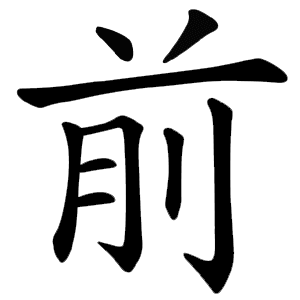前
- front;
- before, earlier;
- ahead;
- in the future;
Etymology
The original form of this character was 歬.
Oracle bone script (甲骨文 jiǎgǔwén):
Depict 止 (foot) under what looks like 舟 (boat), with paths (行) drawn on either side.
This pictogram was interpreted as “a boat moving forward,” leading to the meaning “front, ahead.”
Alternative interpretation:
Similar to the old form of 履 (신 리, “to wear shoes”), the 舟 shape may have represented a shoe, implying “wearing shoes and moving forward.”
Bronze inscriptions (金文 jinwen) and Small Seal script (소전):
Some forms omit the side 行 components.
Clerical script (隸書 lìshū):
The modern form developed here, with 止 and 舟 becoming distorted into the components 䒑 and 月 in their current forms.
Variant with 刀:
In seal script (篆書 zhuànshū), a version with 刀 (knife) added (𣦃 / 𠝣) appeared to convey the sense of “to cut.”
Later, the cutting meaning split off into the separate character 剪 (자를 전), while 前 reverted entirely to meaning “front.”
Usage in Korean
In academic or formal writing, 前 is also used to mark B.C. dates. For example: 前 120년 = “120 B.C.”
Words that derived from 前
- 공전(空前)–being unprecedented
- 기원전(紀元前)–B.C
- 사전(事前)–being prior; being beforehand; being preliminary
- 안전(案前)–before one's eyes
- 여전히(如前히)–just as it was before
- 이전(以前)–previous time; before
- 전과(前科)–criminal records
- 전날(前날)–previous day; past
- 전달(前달)–last month; previous month
- 전도(前途)–prospect; future; road ahead
- 전반(前半)–first half
- 전자(前者)–earlier; the other day; the former
- 전제(前提)–assumption; condition
- 전진(前進)–moving forward; improvement; advances
- 전편(前篇)–previous volume; prequel
- 전후(前後)–front and rear; being immediate; cause; circumstance; being around
